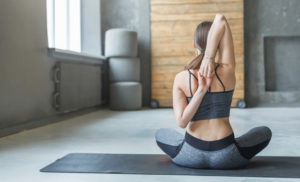What is a yoga new year’s resolution?

A resolution is a promise to yourself to do or not do something. Every December, most of us make one or more of them, and by mid-January 90% of us have given them up. As a yoga teacher I’ve taught the packed January classes and beginner courses and tried not to take it too personally when classes diminished in size each week. Resolutions do not work!
A yoga new year’s resolution is often a measurable goal. It is placing faith in the belief that reaching some external marker will bring you happiness. In the yoga world, this might look like starting a practice, making a practice more consistent, or finally executing some difficult posture. My friend and colleague Sarah Scharf, in her book Holding Space, differentiates these types of goals, which may or may not actually bring you contentment, from intentions which ‘do not place the focus on outcome’ but on the ‘quality of the process’ as ‘simply wanting to be better at something creates layers of tension within us.’
So, resolution-making and seeking external goals probably won’t make you as happy as you think and often doesn’t work – yet we do it year after year. What’s going on here? Can we re-direct this energy into a more helpful pathway?
Why do resolutions fail?
Without getting lost in neuroscience, it’s important to understand the full-body process that is occurring when you try, successfully or not, to motivate yourself into achieving goals. Rick Hanson in Neurodharma explains:
Top-down intentions engage the prefrontal cortex behind the forehead. This part of the brain is the primary neural basis for the executive functions, including deliberate control of attention, emotion, and action. This kind of intention is very useful, but it is effortful and thus vulnerable to willpower fatigue: it’s tiring to have to keep telling yourself to do something. Additionally, the rewards of achieving the intention are deferred into the future, which can sap motivation. On the other hand, bottom-up intention engages your emotions and sensations, drawing on older and therefore more fundamental neural structures below the cortex. In this form of intention, you find a felt sense of what it would be like to have already fulfilled the intention, and then give yourself over to it. This feels rewarding already, and therefore more motivating. Instead of struggling upstream, you feel carried along.
Rick Hanson
The list-making, the schedules, and the force of will-power, as the statistics and science tell us, will fizzle out. If we want to stay committed to our practice and fuelled by an enthusiasm that sustains it, we have to embody our intentions.

Try full-body intentions
I believe the sustaining of a disciplined and consistent practice and whatever shapes you make will emerge as a natural outcome of a commitment to your own compassionate care and well-being. This begins with continual intention-setting. When you are determining the direction, attitude, and intention of your practice, try this approach that incorporates not only a mental focus, but a variety of physical and emotional inputs.
- Check-in with how you are physically and mentally feeling and determine your intention for today. It can be a present moment statement of what you need your practice to be to meet your current state.
- Visualise a time where you felt like you actualised this intention. What did it feel like in your breath, in your body, in your gut, in your heart, or anywhere else you notice?
- Visualise a future where you have actualised this intention. What does it feel like in your breath, in your body, in your gut, in your heart, or anywhere else you notice?
- Imagine you have actualised this intention now. What does it feel like in your breath, in your body, in your gut, in your heart, or anywhere else you notice?
- Remind yourself of why you practice not just today, but overall. You can reflect on questions you are exploring or qualities you are hoping to reveal (see below). Mentally state this reason and repeat the visualisation process from above.
Whenever you feel like you are losing focus, meaning, or stamina in your practice, make sure to revisit this process. You can also switch the order and begin with your overall reason for practising.
Ask yourself a question
There is an enormous weight of social pressure that tells us we need to be different or better than we are now, so it’s only human that we are affected by these messages. It will be a much longer conversation if we critically query what motivates our new year’s resolutions, but can we do our best to listen deep down to the needs of a heart that longs to awaken?
Instead of a new year’s yoga resolution, I tend to think about questions I want to explore or qualities I want to reveal in the new year. I say ‘reveal’ because they are already there, just obscured by harmful views or patterns. The Buddhist Paramitas or Brahmaviharas are as good a place as any to start your journey. For example, from their teachings I might ask ‘what does lovingkindness mean in my life?’ You can start exploring this content on an online course I offered with Mimi Kuo-Deemer on Movement for Modern Life. You may also choose a sutra, a yama, or a niyama from Patanjali.
But here’s the important thing, expect that there will be a time where your enthusiasm fades. Welcome this moment. Befriend this moment. Pause, reflect, and maybe change course if necessary.
Resolutions, goals, intentions, or whatever you want to call them aren’t just important over a glass of bubbly on New Year’s Eve. They are an ongoing, every moment process that can help you live a life of contentment and meaning.
The post Resolution Re-Think appeared first on Adam Hocke Yoga.
What are resolutions, why do they fail, and what else can we do?
The post Resolution Re-Think appeared first on Adam Hocke Yoga. Read More
Read More







